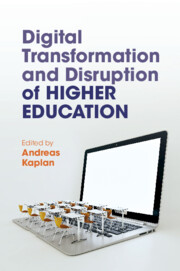Book contents
- Digital Transformation and Disruption of Higher Education
- Digital Transformation and Disruption of Higher Education
- Copyright page
- Contents
- Figures
- Tables
- Contributors
- Preface
- Chapter 1 Nothing Is Constant Except Change
- Part I (R)evolution of the Higher Education Sector
- Chapter 2 Higher Education’s Digitalisation
- Chapter 3 Online Learning
- Chapter 4 Social Exclusion and the Digital Divide
- Chapter 5 Internationalisation of Higher Education
- Chapter 6 Africa’s University Landscape
- Part II Changes in Teaching Formats
- Part III Changes in Teaching Content
- Part IV Networking and Social Activities
- Part V Certification and Diplomas
- Part VI Careers and Professionalisation
- Part VII Futuristic and Ultramodern Higher Education
- Part VIII Higher Education in Motion
- Editor’s Biography
- Index
- References
Chapter 4 - Social Exclusion and the Digital Divide
Digitalisation’s Dark Side
from Part I - (R)evolution of the Higher Education Sector
Published online by Cambridge University Press: 09 June 2022
- Digital Transformation and Disruption of Higher Education
- Digital Transformation and Disruption of Higher Education
- Copyright page
- Contents
- Figures
- Tables
- Contributors
- Preface
- Chapter 1 Nothing Is Constant Except Change
- Part I (R)evolution of the Higher Education Sector
- Chapter 2 Higher Education’s Digitalisation
- Chapter 3 Online Learning
- Chapter 4 Social Exclusion and the Digital Divide
- Chapter 5 Internationalisation of Higher Education
- Chapter 6 Africa’s University Landscape
- Part II Changes in Teaching Formats
- Part III Changes in Teaching Content
- Part IV Networking and Social Activities
- Part V Certification and Diplomas
- Part VI Careers and Professionalisation
- Part VII Futuristic and Ultramodern Higher Education
- Part VIII Higher Education in Motion
- Editor’s Biography
- Index
- References
Summary
This chapter explores the digitalisation of higher education in the era of the Fourth Industrial Revolution (4IR), where technology is used to support teaching and learning. This conceptual chapter contends that technology uptake and use by institutions of higher learning has been inevitable in the recent past due to a number of factors, with the latest being the COVID-19 global pandemic. Central to the argument of the chapter is the fact that technology is pertinent for the transformation of teaching and learning. However, in some developing countries, especially those of Africa, digitalisation, noble as it is, has resulted in undesirable consequences. Many citizens of the developing countries have been affected by the dark side of technology uptake, which has brought with it social exclusion and digital divide. As much as they need technology for teaching and learning, findings are that factors such as lack of access to internet, shortage of equipment and lack of skills, among others, have proved to be barriers to effective online teaching and learning. The chapter is guided by van Dijk’s Resources and Appropriation Theory.
Keywords
- Type
- Chapter
- Information
- Publisher: Cambridge University PressPrint publication year: 2022
References
- 1
- Cited by

